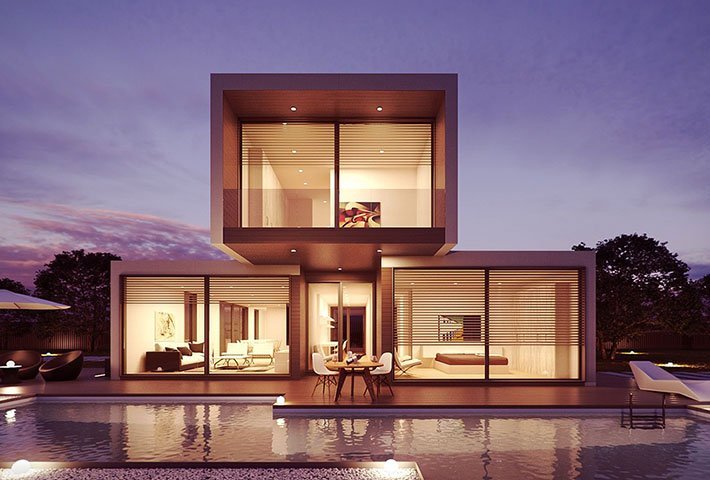Exploring the Benefits of Modern Home Style in Contemporary Design
The exploration of contemporary home design within contemporary style reveals an innovative interaction between aesthetic allure and functional effectiveness. By focusing on elements such as energy effectiveness, enhanced interior air quality, and liquid changes in between indoor and outdoor rooms, contemporary styles provide to the progressing demands of today's home owners.
Boosted Power Performance
In modern home style, one commonly uncovers a significant concentrate on improved power effectiveness, which is critical in dealing with increasing energy costs and environmental issues. Architects and contractors are increasingly integrating ingenious style methods and progressed technologies to optimize energy use in property spaces. This paradigm shift is driven by a growing awareness of sustainability and the demand to lower carbon footprints.
Key features of energy-efficient homes consist of superior insulation, energy-efficient windows, and making use of sustainable products. These layout elements operate in tandem to lessen warmth loss in wintertime and lower heat gain in summer, making sure a comfortable living setting year-round. In addition, contemporary homes frequently include eco-friendly energy resources, such as photovoltaic panels, which not just decrease reliance on non-renewable power but additionally give prospective expense savings for home owners.
Improved Indoor Air Quality
Prioritizing enhanced indoor air top quality has come to be a characteristic of contemporary home style, as home owners progressively recognize the importance of a healthy living setting. Contemporary design incorporates sophisticated products, air flow systems, and clever innovation to advertise cleaner air within residential spaces.

Moreover, the design of modern-day homes frequently emphasizes natural ventilation, enabling fresh air to flow and lowering reliance on synthetic climate control. Tactically positioned home windows, skylights, and vents facilitate air flow, adding to an environment that fights indoor air stagnancy.
Furthermore, including biophilic layout aspects, such as interior plants, not only improves aesthetic charm but likewise serves to cleanse the air. modern home architecture melbourne. Overall, by concentrating on improved interior air high quality, contemporary home style not just enhances the comfort and health of its passengers but additionally fosters a lasting living setting that straightens with contemporary health and health criteria

Smooth Indoor-Outdoor Link
As contemporary property owners seek to enhance their living experiences, the principle of a seamless indoor-outdoor connection has acquired considerable traction great post to read in modern architecture. This style ideology obscures the borders in between interior rooms and the native environment, promoting an unified conjunction that improves every day life.
Building elements such as large sliding glass doors, huge windows, and open flooring strategies facilitate this link, enabling areas to stream effortlessly from indoors to outdoors. These attributes not only develop a sense of openness but likewise encourage involvement with nature, which can have extensive effects on mental well-being.
Additionally, a smooth indoor-outdoor link enhances the functionality of living areas. Exterior areas can work as expansions of the home, fitting numerous activities such as eating, enjoyable, or leisure. By integrating landscaping and exterior furnishings that complement interior decoration, home owners can develop inviting environments that accommodate diverse lifestyles.
In addition, this building approach usually stresses sustainability, as natural ventilation and passive air conditioning methods reduce reliance on artificial climate control. Eventually, welcoming a smooth indoor-outdoor link promotes a more lively, dynamic, and health-conscious living experience.
Making Best Use Of All-natural Light
All-natural light is a crucial element in modern home design, substantially boosting both visual appeal and occupant health. The tactical consolidation of large windows, skylights, and open rooms enables all-natural light to flooding insides, producing lively and inviting settings. This layout method not just boosts the visual charm of a home yet also fosters a link to the outdoors, advertising a sense of serenity and openness.
Additionally, maximizing all-natural light contributes to power effectiveness, reducing dependence on synthetic illumination throughout the day. Homes designed with this principle in mind typically feature reflective surfaces and light-colored products that amplify the impacts of all-natural light, guaranteeing that rooms feel bright and airy. This not just improves comfort yet also reduces energy prices.
Furthermore, direct exposure to natural light has been linked to boosted mood and efficiency among owners. By creating well-lit spaces that encourage communication and activity, modern-day architecture can dramatically affect the high quality of life within the home. Ultimately, the thoughtful assimilation of all-natural light is a hallmark of contemporary style, blending capability with beauty while promoting a much go to this site healthier living setting.
Modification and Flexibility
The emphasis on optimizing all-natural light in modern-day home design perfectly matches the discover this concepts of modification and adaptability. This architectural approach deals with specific preferences, permitting homeowners to tailor their space to meet their special demands and lifestyles. Customization in style makes it possible for the assimilation of personal appearances, whether with the selection of products, color combinations, or spatial setups.
Versatility is another foundation of modern architectural patterns, assisting in adaptive living settings that can progress gradually. Open flooring strategies, movable dividings, and multifunctional rooms are key functions that sustain dynamic living setups. These aspects empower home owners to create locations that can change for numerous functions-- whether for work, recreation, or celebrations-- boosting usability without jeopardizing design.
Furthermore, the integration of wise home modern technology better intensifies modification. Ultimately, customization and adaptability in modern home style foster a much deeper link between individuals and their living areas.
Final Thought
In recap, modern home design in modern design offers numerous benefits, including improved power effectiveness, boosted indoor air high quality, seamless indoor-outdoor links, made best use of natural light, and boosted customization options. These aspects collectively add to much healthier living environments and promote lasting methods, inevitably profiting both homeowners and the more comprehensive community. The innovative integration of looks and performance within modern design not only boosts the high quality of life but additionally sustains a much more eco conscious future.